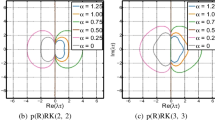Abstract
A novel numerical time integration for solving phase-field problems is presented. This method includes the generalized single step single solve (GSSSS) family of algorithms, which can preserve second-order time accuracy as well as provide controllable numerical dissipation independently on each time variable. Furthermore, we demonstrate an enhancement of the time integration method that can reduce numerical oscillation of differential algebraic equation from phase-field model. The algebraic equation is evaluated at \(t_{n+1}\) instead of the general time level \(t_{n+W_{1}}\). The enhancement reduces the numerical oscillation due to the non-dissipative scheme. Two popular phase-field examples, the Cahn–Hilliard equations and simple phase-field-crystal equations, are used to demonstrate the capability of proposed time integration scheme. We conclude that this approach has a significant advantage over currently used algorithms, and provides a new avenue for robustness of time integration schemes for phase-field problems with a high-order term in free energy.











Similar content being viewed by others
References
C. Andersson, Phase-field simulation of dendritic solidification. Unpublished PhD thesis. Royal Institute of Technology, Stockholm (2002)
V.E. Badalassi, H.D. Ceniceros, S. Banerjee, Computation of multiphase systems with phase field models. J. Comput. Phys. 190(2), 371–397 (2003)
W.J. Boettinger, J.A. Warren, C. Beckermann, A. Karma, Phase-field simulation of solidification 1. Ann. Rev. Mater. Res. 32(1), 163–194 (2002)
K.E. Brenan, S.L. Campbell, L.R. Petzold, Numerical Solution of Initial-Value Problems in Differential-Algebraic Equations, vol. 14 (SIAM, Philadelphia, 1996)
L.-Q. Chen, Phase-field models for microstructure evolution. Ann. Rev. Mater. Res. 32(1), 113–140 (2002)
G.J. Fix, in Free Boundary Problems: Theory and Applications, vol. II, ed. by A. Fasano, M. Primicerio (Piman, Boston, 1983), p. 580
H. Gomez, T.J.R. Hughes, Provably unconditionally stable, second-order time-accurate, mixed variational methods for phase-field models. J. Comput. Phys. 230(13), 5310–5327 (2011)
H. Gomez, X. Nogueira, An unconditionally energy-stable method for the phase field crystal equation. Comput. Methods Appl. Mech. Eng. 249, 52–61 (2012)
H. Gomez, A. Reali, G. Sangalli, Accurate, efficient, and (iso) geometrically flexible collocation methods for phase-field models. J. Comput. Phys. 262, 153–171 (2014)
M.E. Gurtin, Generalized Ginzburg–Landau and Cahn–Hilliard equations based on a microforce balance. Phys. D Nonlinear Phenom. 92(3), 178–192 (1996)
A.J. Hoitink, Application of the GSSSS family of algorithms to the natural index 3 differential-algebraic equations of multibody dynamics. PhD thesis, University of Minnesota (2011)
J. Hua, P. Lin, C. Liu, Q. Wang, Energy law preserving \(c^0\) finite element schemes for phase field models in two-phase flow computations. J. Comput. Phys. 230(19), 7115–7131 (2011)
T.-H. Huang, T.-H. Huang, Y.-S. Lin, C.-H. Chang, P.-Y. Chen, S.-W. Chang, C.-S. Chen, Phase-field modeling of microstructural evolution by freeze-casting. Adv. Eng. Mater. 20(3), 1700343 (2018)
T.J.R. Hughes, The Finite Element Method: Linear Static and Dynamic Finite Element Analysis (Courier Corporation, Chelmsford, 2012)
A. Karma, D.A. Kessler, H. Levine, Phase-field model of mode III dynamic fracture. Phys. Rev. Lett. 87(4), 045501 (2001)
R. Kobayashi, A numerical approach to three-dimensional dendritic solidification. Exp. Math. 3(1), 59–81 (1994)
J.S. Langer, Models of pattern formation in first-order phase transitions. Dir. Condens. Matter Phys. 1, 165–186 (1986)
C. Liu, J. Shen, A phase field model for the mixture of two incompressible fluids and its approximation by a Fourier-spectral method. Phys. D Nonlinear Phenom. 179(3), 211–228 (2003)
S.U.B. Masuri, M. Sellier, X. Zhou, K.K. Tamma, Design of order-preserving algorithms for transient first-order systems with controllable numerical dissipation. Int. J. Numer. Methods Eng. 88(13), 1411–1448 (2011)
D. Negrut, R. Rampalli, G. Ottarsson, A. Sajdak, On the use of the HHT method in the context of index 3 differential algebraic equations of multibody dynamics. In ASME 2005 International Design Engineering Technical Conferences and Computers and Information in Engineering Conference (American Society of Mechanical Engineers, 2005), pp. 207–218
L.R. Petzold, A description of dassl: a differential/algebraic system solver. Sci. Comput. 1, 65–68 (1982)
S. Praetorius, A. Voigt, Development and analysis of a block-preconditioner for the phase-field crystal equation. SIAM J. Sci. Comput. 37(3), B425–B451 (2015)
N. Provatas, K. Elder, Phase-field methods in materials science and engineering (Wiley, Hoboken, 2011)
N. Provatas, N. Goldenfeld, J. Dantzig, Adaptive mesh refinement computation of solidification microstructures using dynamic data structures. J. Computat. Phys. 148(1), 265–290 (1999)
M. Shimada, Novel design and development of isochronous time integration architectures for ordinary differential equations and differential-algebraic equations: computational science and engineering applications. PhD thesis, University of Minnesota (2014)
M. Shimada, A.J. Hoitink, K.K. Tamma, The fundamentals underlying the computations of acceleration for general dynamic applications: issues and noteworthy perspectives. CMES Comput. Model. Eng. Sci. 104(2), 133–158 (2015)
M. Shimada, S.U.B. Masuri, K.K. Tamma, A novel design of an isochronous integration [iintegration] framework for first/second order multidisciplinary transient systems. Int. J. Numer. Methods Eng. 102(3–4), 867–891 (2015)
K.K. Tamma, M. Shimada, S.U.B. Masuri, X. Zhou, Computer-implemented method for performing simulation, June 25. US Patent App. 14/314,925 (2014)
P. Vignal, L. Dalcin, D.L. Brown, N. Collier, V.M. Calo, An energy-stable convex splitting for the phase-field crystal equation. Comput. Struct. 158, 355–368 (2015)
X. Zhou, K.K. Tamma, Design, analysis, and synthesis of generalized single step single solve and optimal algorithms for structural dynamics. Int. J. Numer. Methods Eng. 59(5), 597–668 (2004)
Acknowledgements
We would like to acknowledge the help regarding GSSSS time integration method from Dr. Shimada and Prof. Tamma at University of Minnesota, Twin Cities. We are grateful for the computational resources from National Center of High-performance Computing (NCHC). This work is supported by the Industrial Technology Research Institute (ITRI) at Hsinchu, Taiwan.
Author information
Authors and Affiliations
Corresponding author
Rights and permissions
About this article
Cite this article
Huang, TH., Huang, TH., Lin, YS. et al. A Time Integration Method for Phase-Field Modeling. Multiscale Sci. Eng. 1, 56–69 (2019). https://doi.org/10.1007/s42493-018-00007-9
Received:
Revised:
Accepted:
Published:
Issue Date:
DOI: https://doi.org/10.1007/s42493-018-00007-9




